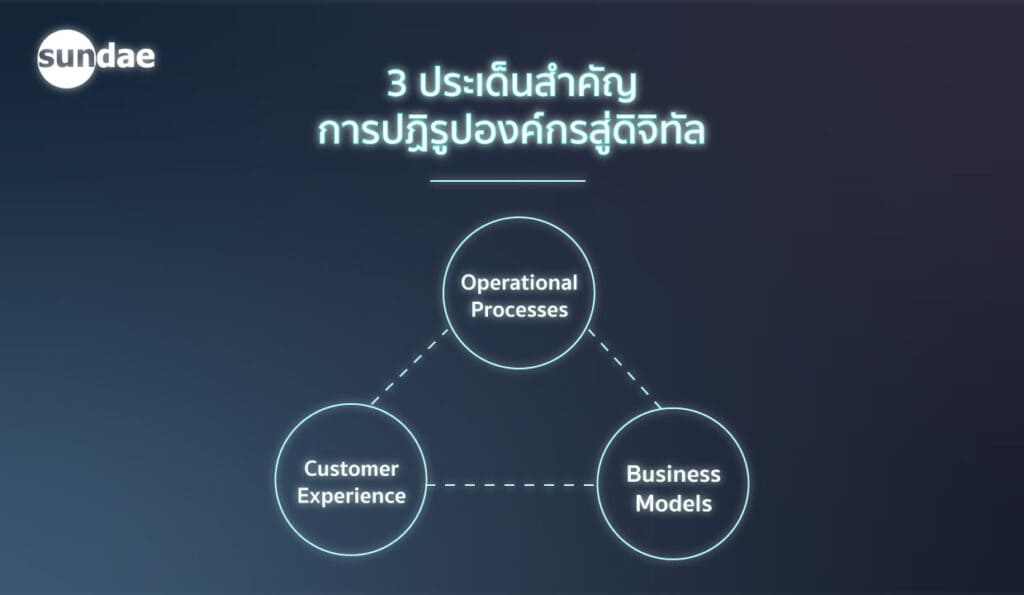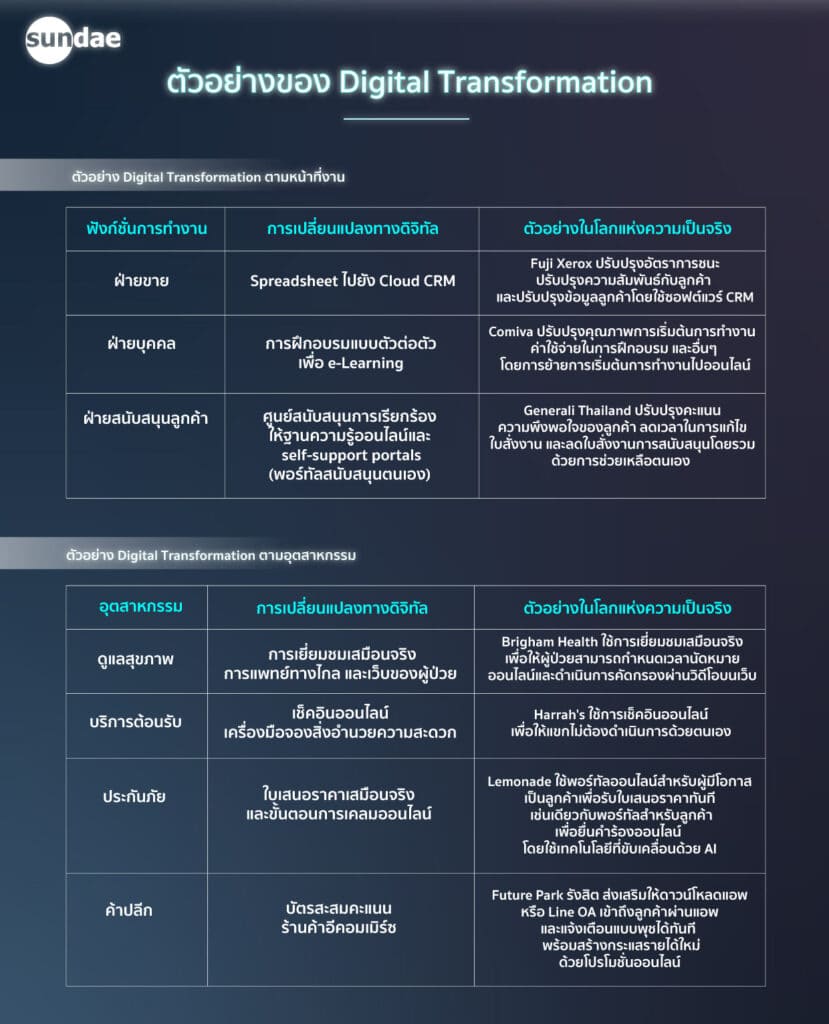What is Digital Transformation?
- January 17, 2022
- Posted by: Siriluck Sukitphittayanon
- Category: Articles-EN


Digital transformation It is the process of using digital technology to transform traditional and non-digital business processes and services, or to create new processes to meet the changing market and customer expectations. It has completely changed the way business is managed and run. Value sent to customers
According to Deloitte, “Digital transformation is about being a digital organization — one that uses technology to continually improve all aspects of its business model. (what is presented How to interact with customers and how to proceed)”
As technology develops So should your business at this point. It’s not about the organization choosing to change. It’s more about deciding how to transform.
Digital transformation It is about evolving your business by experimenting with new technologies and rethinking your current approach to solving common problems. because it is evolution Change doesn’t have to have a clear end. MIT Sloan Management Review, a publication highlighting change management in the digital age, says, “Digital transformation should be about continual adaptation to an ever-changing environment. “
For organizations, that means constantly seeking ways to improve the user experience. This may be done by improving the training as needed. Migrating data to cloud services Utilizing Artificial Intelligence and more

3 Key Points of Digital Transformation
MIT Sloan Management Review Highlights Three Key Areas of Digital Transformation For organizations:
1. Customer Experience — Work to understand customers in more detail. Use technology to drive customer growth. and create more customer touchpoints
2. Operational Processes — Streamline internal processes by leveraging digitization and automation. Empower employees with digital tools and collect data to monitor performance and make more strategic business decisions.
3. Business Models — Transform businesses by enhancing their physical offerings with digital tools and services. digital product introduction and using technology to provide shared services around the world.
What is the importance of Digital Transformation?

While every digital transformation initiative has its own specific goals. The main purpose of Digital Transformation is to improve your current process. Digital transformation matters Because companies Must be developed to be able to compete in their industry. If you don’t develop, you’re falling behind.
A Bain & Company study shows that “only 8% of companies worldwide are able to achieve their target business outcomes by investing in digital technology.” One strategy that differentiates leaders is that they spend more on Transforming business instead of just operating
Digital Transformation is important because it allows organizations to adapt to an ever-changing industry and continually improve the way they operate.
For organizations, that means constantly seeking ways to improve the user experience. This may be done by improving the training as needed. Migrating data to cloud services Utilizing Artificial Intelligence and more
Benefits of Digital Transformation
While Digital Transformation’s ROI depends on many factors, the right technology can dramatically improve the way your business operates and the way your customers engage with it.
1. Increase productivity while reducing labor costs (Business Models) — Using technology to work more efficiently is one of the most effective ways to transform your business. For example, for entrepreneurs, the time and money they spend training new employees and improving digital resources can quickly get out of hand. With the right tools you can keep costs down and productivity increased.
2. Improve the customer experience — Tech Savvy customers want great experiences through multiple communications — mobile apps, social media, email, live chat, etc.
Digital Transformation is the driving force behind the improved customer experience.
3. Driving Innovation to Competitiveness — Your competitors are looking for Digital Transformation whether you implement it or not. Choosing not to accept digital transformation means you are not interested in being left behind.
Examples of Digital Transformation
Digital Transformation happens in every industry and every function. We have given examples of digital Transformation in the real world, so you can better understand the meaning of Digital Transformation.

The most important aspects of Digital Transformation.
To succeed in transformation, keep the momentum of any initiative moving towards your ultimate business goal. In doing so, continually talk about Digital Transformation’s core drivers: Digital Twins, Privacy, Culture, Augmented Intelligence and Digital Product Management
According to Gartner, Chief Technology Operations (CIOs) need to focus on these 5 areas to enable successful Digital Transformation in their organizations.
1. Digital Twins
Gartner defines a digital twin as “A digital representation of a real-world entity or system. The implementation of a digital twin is an encapsulated software object or model that mirrors a unique physical object, process, organization, person or other abstraction. ”
Digital Twins support Digital Transformation because it facilitates experimentation and gathering data that supports more informed business decisions.
2. Privacy
If you can’t manage your privacy, your Digital Transformation will fail. As more digital solutions become available, organizations It tends to jump on trends that offer more comfort. However, Gartner research reveals that most consumers and employees are reluctant to forgo security for convenience. CIOs need to take privacy seriously. Employees and consumers will not support the change if they feel it violates their privacy or security of personal information.
3. Culture
Resisting change is a human instinct. When you ignore the cultural aspects of Digital Transformation You quickly start to hit a wall of resistance. In fact, 46% of CIOs say culture is the biggest barrier to change. Managing culture helps you get feedback from within your organization for your change initiatives. When you have a change leader (who Support for your Digital Transformation) You can use their voice to move your initiative forward.
4. Augmented Intelligence
Artificial intelligence is more than artificial intelligence (AI). It enables humans and machines to work in tandem. AI’s data collection and analysis capabilities are far superior to human workers, but augmented intelligence is not about replacing employees with machines — AI collects and presents data in a way that helps people increase their knowledge.
5. Digital Product Management
Gartner explains that digital product management is a shift in thinking from project to product. Those products must be designed to improve the customer experience and delivered through digital channels. Digital product management is all about knowing your industry and designing products that serve it. For example, instead of expecting the healthcare industry to align with Apple’s offerings, Apple has created a watch that monitors the health of CIO-focused wearers. Go to these five key drivers to stay ahead of your competitors by continuously improving and expanding your business.
What will cause Digital Transformation to fail?
Digital Transformation can fail for many reasons. But there are three main issues that can be linked back to digital transformation challenges: people, communication, and measurement.
1. People
People can make or break your Digital Transformation. Remember: Culture is both the top driver of Digital Transformation and one of the six pillars of its success. If you don’t pay enough attention to people and culture, your initiative will surely fail. Sixteen of McKinsey’s 21 keys to Digital Transformation success involve people.
2. Bad communication
Announcing a Digital Transformation initiative is not the same as communicating with a team. Often, leaders simply authorize change without explaining why and how. If you don’t give specific, actionable advice before, during, And even after the change, your initiative will not go very far. You can learn more by reading our guide to changing communications.
3. lack of measurement results
You can’t succeed in digital transformation if you don’t define what success means to you. Sometimes companies assume that they can monitor success based on key performance indicators (KPIs) that they have set for their business. But if you’re changing the way you do business. You will need to set additional KPIs to monitor the impact.
How to get started with digital transformation
The Digital Transformation strategy is an action plan to introduce Analyze and drive initiatives forward. Your strategy will define the business goals you want to achieve through Digital Transformation.
An effective Digital Transformation strategy creates a framework for you to follow throughout this ever-evolving process. But before you begin, it’s important to know what you hope to achieve in order to set KPIs to track along the way.
For example, if you are migrating users from one system to another. Your top metrics for measuring adoption will be logging rate, usage, data quality, and business performance.
In this case, you may dig further and examine metrics such as:
- Monthly Sales Volume
- opportunity created
- Sales performance (e.g. time savings, sales activity volume per agent)
- User Login Rate
- Prospect account with key fields
A thoughtful strategy addresses how change will impact your customers and employees, starting internally by identifying a change leader who will publicly support your change, placing a trusted change leader responsible for evangelism and advocacy. Change builds momentum, soliciting feedback from everyone affected by change regularly will help keep the momentum going.
Be sure to include your team’s achievements as part of your progress tracking. Whether you’re pointing out success quantitatively, such as a 10% increase in user login rates, or qualitatively, such as Sundae Solutions created a Lark group to answer questions about change – celebrating milestones throughout the process is a important.
Customers and employees will turn to those who initiate change to gain the knowledge they need to succeed. Providing the necessary tools is up to you.
Those tools can take many forms. But if you are doing Digital Transformation There is a possibility that There are digital resources that can support your transformation. Will you be using E-learning tools for training?
Please note that change is evolution. Therefore, taking advantage of tools that can be adapted quickly, such as digital adoption platforms, It can save your time and effort.
Digital Transformation Trends
Changes in matters increase and decrease with popularity as technology changes. Following trends is a great way to see how you can improve your own Digital Transformation and prepare for the inevitable changes in your industry.
Right now, the hottest trends in DigitalTransformation are tied to one thing: Creating a better Customer Experience and Employees Experience
Although many people, especially employees, fear that some technologies are designed to replace humans. But big digital transformation involves technologies that enhance human productivity.
AI, Robotic Process Automation, 5G, Mobile Development and personalized user experiences are all examples of a Digital Transformation trend that seeks to work with humans to do everything from improving communication to limiting mundane tasks.

